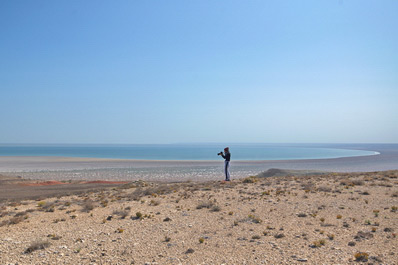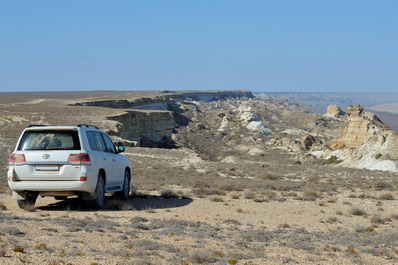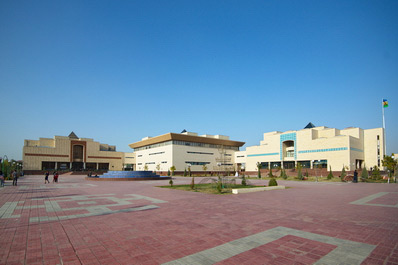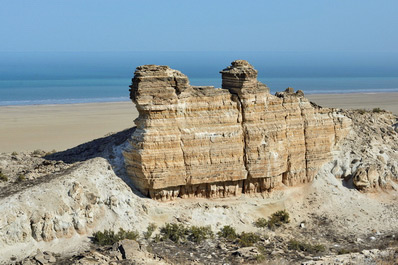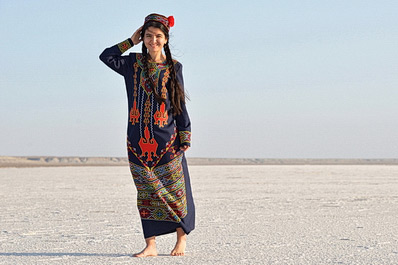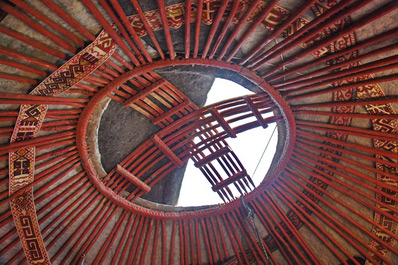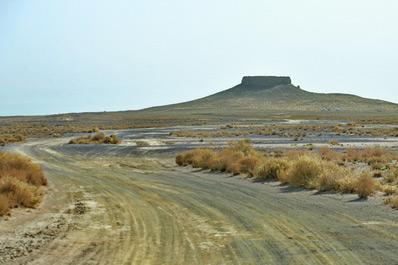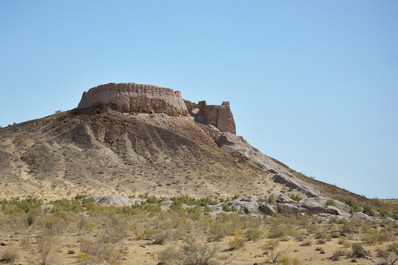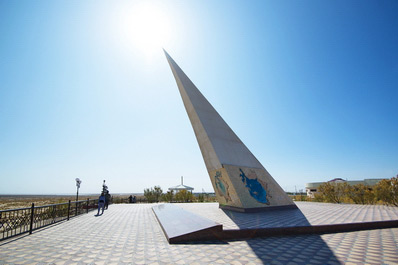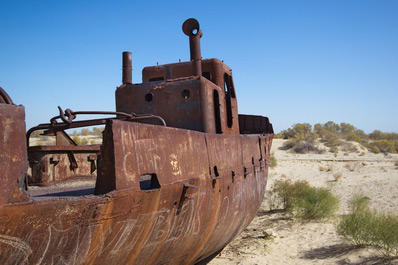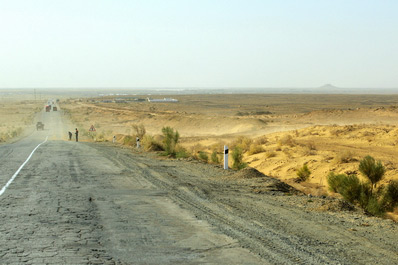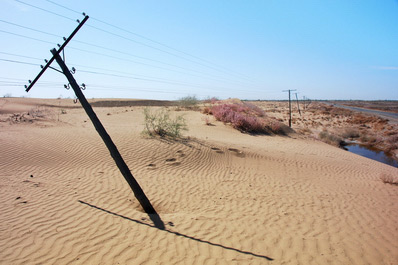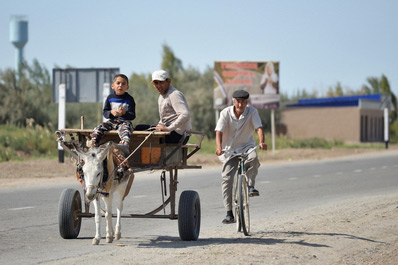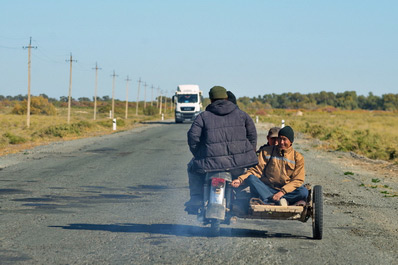Karakalpakstan
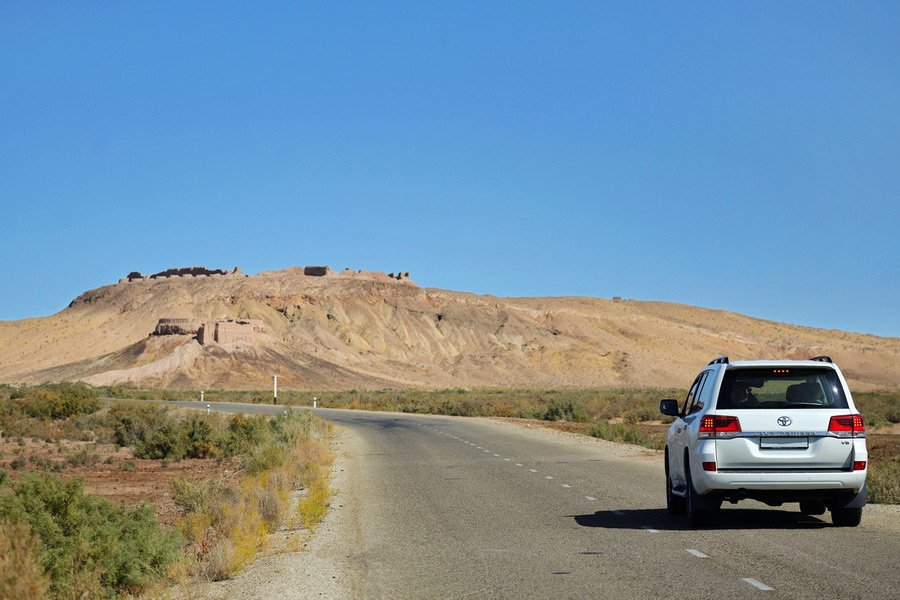
Popular languages: Karakalpak, Uzbek
Nationalities: Uzbek, Karakalpak, Russian, Tatar, Kazakh, Turkmen
Population: 1,842,000 – www.wikipedia.org
Time zone: UTC+5
Automobile codes: 95
Karakalpakstan is an autonomous republic in far west Uzbekistan which occupies a full forty percent of the country's territory and is home to around 2 million people. This quiet corner of Central Asia is slowly rising out of obscurity, having been ranked #2 in a list of Top 10 Destinations by British newspaper The Telegraph in 2015.
Karakalpakstan borders Kazakhstan to the north and Turkmenistan to the west. It has two state languages, Karakalpak and Uzbek, and is primarily populated by the Karakalpaks, a historically semi-nomadic people whose unique culture is evident in their applied arts, national cuisine and mind-boggling ancient sites.
The capital city Nukus was founded on site of an ancient settlement called Shurcha, which was first referred to in 12th-century writings as a military fortress. Interest in the region intensified in the 20th century when a famous archaeological expedition again placed Karakalpakstan on the map. Until the mid-1970s there were some 1200 active archaeological digs in the territory, and while many of these sites were shuttered or remain closed to the public, plenty of ancient remnants still await exploration by the curious tourist.
While Karakalpakstan remains well off the beaten track, it offers adventurous travelers more than enough incentive to visit. The territory has three overlapping deserts - Karakum Desert, Ustyurt Plateau and Kyzylkum Desert – which possess a harsh but mystical beauty. Even more alluring are the hospitable Karakalpaks themselves, who in rural areas are known to welcome strangers like family.
Scattered across Karakalpakstan are a handful of surprisingly diverse and utterly unique sites. Mysterious abandoned ships and avant-garde paintings, Silk Road fortresses and the salty waters of the shrinking Aral Sea all hold clues to Karakalpak culture past and present.
Many secrets of this harsh land have yet to be discovered, and it remains a gold mine for archaeologists, researchers, artists, photographers, filmmakers and thrill seekers. Whether you are seeking historical, cultural, art or adventure tourism, Karakalpakstan is up to the task. Come peer into the past via an endless expanse of desert, where time has stood still for millennia, discovering a beautiful 21st-century culture in the process.
History of Karakalpakstan
Karakalpakstan was inhabited in the Neolithic era by various nomadic peoples whose origins can be traced back to the Saka and Massagetae tribes. In succeeding centuries, the territory was conquered by the Persians, Khorezmians Arabs, Kalmyks and finally the army of Genghis Khan. Although Zoroastrianism was the religion of choice until Islam arrived with the Arabs in the 8th century, the influence of other religions is also evident. Some scholars believe that the territory was consecrated by the apostles Thomas and Andrew and by later preachers who traveled the Great Silk Road to spread their faith. Most Karakalpaks still adhere to Islam, yet there are exceptions, as evidenced by the presence of an Orthodox church in Nukus.
The word "Karakalpak”, which literally translates as “Black Hat”, first appeared in written sources in the 9th century. The first mention of the Karakalpak statehood dates to the end of the 14th century, at which time the Karakalpaks were part of the Nogai Horde led by Khan Edegey. After the Nogai were defeated on the Volga River in the 17th century, the Karakalpaks fled to the shores of the Syr Darya River in present-day Uzbekistan, where they fell under the control of the Bukharan and Khiva khanates.
At the beginning of the 18th century, Karakalpak tribes began uniting into one nationality, and it was through this unification that the Karakalpak Khanate was formed. Over time, the khanate split into two groups, one of which settled near Tashkent and the other along the lower Syr Darya River. In 1873, the Karakalpaks near Tashkent were annexed to the Russian Empire, while those along the Syr Darya remained a part of the Khiva Khanate.
In 1918, both Karakalpak tribes were placed under the Khorezm People's Soviet Republic and the Turkestan Autonomous Soviet Socialist Republic before gaining partial autonomy in 1924. The first capital was in the city of Turtkul before being moved to Nukus, Karakalpakstan in 1932. In 1936, the Karakalpak SSR became a part of the Uzbek SSR. Ever since gaining independence from the USSR in 1991, Karakalpakstan has remained a part of Uzbekistan while retaining many outward attributes of nationhood, including a separate Karakalpakstan flag, constitution and coat of arms.
Many questions regarding the history of the Karakalpak people remain unanswered to this day. For example, in 1966 a marble sculpture of a man’s head with ram horns, legs and a tail was discovered in the foothills of Karakalpakstan. As such figures are typically only found in palaces, this discovery indicates that the history of the people who inhabited these territories was much more complex than originally thought.
Karakalpakstan Applied Arts
Karakalpak woodworking, embroidery, copperwork, carpet weaving and jewelry making are practically as old as the nation itself. An ancient spout and a bronze cauldron with a horse-shaped handle, both discovered in the Ellik Kala fortresses in 1980 and dated to the 6th-5th centuries BC, testify to the antiquity of Karakalpak handicrafts. In later centuries, the Great Silk Road passed through Karakalpakstan, forming a natural bridge with distant countries which was to have a profound role in local art.
Men in Karakalpakstan were traditionally engaged in metal work, woodworking and the construction of houses and yurts. Metal, leather, wood and fabric were used to create gear for horses, a revered animal which was valued as a warrior, means of transport and source of meat. Woodcarving was often a family business which centered on the creation of household items such as chests, cradles, stupas, spindles, musical instruments and dishes. Today there are Karakalpak woodcarvers whose families have been engaged in the craft for fourteen generations and copper minters who can trace their dynasty back eighteen generations.
The construction of the yurt is one of the most unique expressions of Karakalpak culture. Karakalpak yurts differed from Kazakh, Turkmen and Kyrgyz variants both in their structure and in their rich interior decor. Today these yurts are still used as seasonal dwellings by some Karakalpaks in the countryside and, more commonly, as guest houses for tourists, who can even take a class from village craftsmen to learn the secrets of yurt assembly. Carpet weaving among the nomadic Karakalpaks arose from both the need to protect their yurts from the biting winter winds and the desire to beautify these portable dwellings. The carpet’s precise size, shape, color, pattern and style would vary based on its intended purpose.
Since Karakalpaks can trace their origins back to the Saka and Massagetae tribes who were famous for their gold, silver and copperwork, it comes as no surprise that Karakalpak jewelry is distinguished for its delicate beauty and originality. Local accoutrements may be divided into everyday, ceremonial and festive jewelry. They are usually made from silver, are very heavy and are decorated with gold, pearls or turquoise. Women's jewelry plays an integral part in Karakalpak tradition, for it indicates both the lady’s social status and her age. In childhood, girls wear amulets on their hands and feet as protection from the evil eye. Brides are adorned with a special belt and necklace which serve the same purpose, as well as many rings, bracelets and earrings. A woman stops wearing jewelry either after the death of her husband or when she becomes a grandmother, for it is believed that during the final stage of her life she has nothing to fear.
Traditional Karakalpak embroidery conveyed the local worldview, and typical depictions included stars, horns, hooves, flowers, plants and other items common in everyday life. Many of the symbols embroidered into clothing and household items, including images of birds, animals, body parts and floral and geometric patterns, were designed to protect against misfortune and the evil eye. Local dresses had simple motifs on the hemlines, along the silk collar and on the chest. In place of hijabs, Karakalpak women wore headdresses called saukele onto which precious metals and stones were sewn. (The oldest known saukele dates back to the 6th-5th centuries BC.) Sacred ornaments were embroidered with twelve basic patterns as a reminder of the twelve indigenous Karakalpak tribes, each of which laid claim to a unique pattern.
Karakalpak Cuisine
Karakalpak cuisine has absorbed the culinary traditions of many Central Asian peoples, including the belief that cooking and eating should never be hasty affairs. Meal preparation in Karakalpakstan requires much time and skill, while hosting guests is akin to a sacred rite which must include copious amounts of food, generosity, attention to guests, respect for the host, leisurely conversation and an unhurried environ.
The Karakalpaks favor meat dishes such as kuurdak (fried meat), shashlik (shish kebab) and besh barmak (meat with boiled dough). Dishes made from fermented milk products are also very popular, including katyk (fermented milk), katikli (hot soup based on katyk) and chalop (cold soup made from katyk).
Other dishes comprised of meat, rice, dough, sorghum, millet and mung beans which are popular throughout Central Asia may also be found in Karakalpakstan, albeit with slight modifications. Many of these foods were not originally a part of the nomadic people’s diet but were incorporated into local cuisine in the past century.
To taste a truly authentic Karakalpak dish, try zhueri gurtik, a type of dumpling made from millet flour. The bazaar in Nukus sells a special flatbread and turak, a spicy and sometimes smoked dried cheese product. Korma fish soup and turam, a dish made from thinly sliced lamb and noodles, is also very popular in the region.
Karakalpak people drink green and black tea with milk and fresh dairy products including katyk, ayran (yogurt) and kumis (horse milk). However, it is advisable to avoid eating fatty foods with dairy products prior to a long journey!
Karakalpakstan Tourism
Karakalpakstan was classified territory during the Soviet era due to military bases stationed in the region, yet in recent times its infrastructure has slowly developed as a budding tourism industry gains momentum.
Among the historical highlights are the astonishing Desert Castles of Ancient Khorezm, the most treasured monuments in the region. Ancient history aside, the region’s eventful 20th- century past remains tangible at Savitsy Museum, guardian of one of the world’s largest and most unusual collections of avant-garde art, and at the sobering Muynak Ship Graveyard and Aral Sea, vestiges of the sweeping ecological tragedy which defined Karakalpakstan in the last century.
Key Attractions
Desert Castles of Ancient Khorezm
Ellik Kala Fortresses (Fifty Fortresses), better known as the Desert Castles of Ancient Khorezm, is a UNESCO-recognized string of 8 citadels which were built around an oasis near Uzbekistan’s Karakum Desert. Counted among the oldest sites in Karakalpakstan Region, the defensive structures were constructed between the 4th century BC- 9th century AD and were inhabited until medieval times, when they were likely abandoned following a 13th-century Mongol invasion.
The castles were rediscovered in the 1930s by famed Soviet archaeologist Sergei Pavlovich Tolstov, who was accompanied on his expedition by Igor Savitsky, the founder of the Nukus museum which now bears his name. Their research determined that the forts served to protect nearby villages from enemy raids and that at least one (Kyzyl-Kala) was a thriving post along the Great Silk Road. Numerous artifacts, Zoroastrian temples and city ruins unearthed at each site now provide invaluable clues into the region’s history.
Among the most significant of the 8 fortresses are Toprak-Kala (1st-5th centuries AD), a fortress-settlement valued for its advanced and complex architecture; Ayaz-Kala (c. 2nd century AD), whose remains are divided into 3 distinct time periods; and Kyzyl-Kala (c. 1st century AD), which was partially restored in the early 21st century. The forlorn castles now welcome visitors to climb their walls and explore their every nook and cranny. Seeing their stately grandeur and historical significance with your own eyes will make the desert drive to reach them from Nukus well worth the effort!
Savitsky Museum
In summer 2009, both the Leisure column in the Sunday supplement of The New York Times and the International Herald Tribune listed Savitsky Museum as a must-see site for art enthusiasts before they die. French ambassador J.K. Richard echoed these sentiments when he referred to the museum’s rich collections as the “Caves of Ali Baba”. Today, the treasures of this remote museum have never been more accessible to the public.
Savitsky Museum - also called Nukus Museum of Art, State Museum of Arts of the Republic of Karakalpakstan and even "Louvre in the Sands" - was founded by legendary Moscow artist Igor Savitsky (1915-1984), a name known to art connoisseurs the world over. Savitsky’s foresight, taste and courage enabled him to identify new artistic trends and up-and-coming artists, prompting him to amass the works of forgotten masters in the museum which he founded in 1966.
After Savtisky’s death in 1984, his student Marinika Babanazarova took over the reins, serving as museum director from 1984 to 2015. Thanks to Babanazarova’s tireless work and ceaseless creativity, the collections at Nukus Museum of Art were expanded and the museum brought to worldwide fame.
Now boasting the largest collection of art in Central Asia, Savitsky Museum contains nearly one hundred thousand works which span more than four millennia. Its fine arts collection includes a conglomerate of national works, famous canvases of the Moscow avant-garde and post-avant-garde of the 1920-1930s and paintings of non-conformists from the Moscow underground of the 1960-1970s. First-class copies of world masterpieces, including items from the Louvre in Paris, are also on display.
Most of the exhibits in the Karakalpak applied arts collection long predate the turbulent 20th century and serve instead as a reflection of the rich local culture. Many of these artifacts, including a display of magnificent jewelry which have no known equivalents, were discovered during excavations of Ellik Kala Fortresses. Visit the Nukus Museum of Art in conjunction with these Desert Castles and you will truly begin to piece together the history embedded in the region.
For a more in-depth experience at Savitsky Museum, guided tours are available. Special stockroom tours for art experts, a concept introduced under Marinika Babanazarova which continues to this day, can also be organized in advance.
Muynak Ship Graveyard
Muynak Ship Graveyard is the site of a once-wealthy fishing town which was founded on the shores of the Aral Sea. Muynak flourished until the Karakum Canal was constructed for the irrigation of cotton fields in the 1950s, a reckless act which led to one of the world’s greatest ecological disasters. The Aral Sea nearly dried up in the ensuing decades, and today its shores are 100 kilometers away from the city. Cargo ships were forced to halt their voyages in 1970, and Karakalpakstan’s Muynak is now little more than a ghost town, with a population of 18,000 people.
Muynak Ship Graveyard is a collection of forlorn, abandoned boats which serve as a glaring reminder of this unnecessary tragedy of nature. The sight of a full lineup of ships, embedded in the desert sands where scarcely a drop of water can now be found, is truly tragic. Visitors are welcome to climb atop the old vessels, take photos and tour the small but informative museum which now sits adjacent to the ships.
Aral Sea
The infamous Aral Sea was once the fourth largest in the world before its waters were tragically drained in the Soviet irrigation project which was launched in the mid-20th century. Now just 10 percent of its original size, the Aral Sea is at the heart of one of the world’s worst ecological disasters which has had an irreversible impact on the region’s flora and fauna.
Karakalpakstan was once home to more than 60 percent of the tugai forests of Central Asia, yet today only 10 percent of this wealth remains. Much of the area is caked in a layer of salt, which has naturally led to a significant decrease in its birds, fish and wildlife. Sixty-three local species are now listed in the Red Book, including the Central Asian cheetah and the Turanian tiger, while several endangered bird and fish species are listed in the International Union for Conservation of Nature (IUCN) Book.
Nevertheless, glimmers of hope for a more promising future can still be found in the region, particularly along the coast of what remains of Karakalpakstan’s Aral Sea. Ride in a 4WD from Nukus via Muynak and the Ustyurt Plateau to reach these now-remote shores, where you can float in its sparkling, salty waters and sunbathe on its shores. Most guests opt to spend the night in nearby yurt camps, where homecooked food, starry skies and a comfortable bed await you. Aral Sea trips help to support the local economy while promising adventure and an eye-opening, firsthand experience of beleaguered and tenacious Karakalpakstan.
Other highlights of Karakalpakstan include:
- Ustyurt Plateau, one of Uzbekistan’s least-visited corners which lies in part between Muynak and the Aral Sea;
- Mizdakhan Necropolis (4th century BC), an archaeological complex whose cemetery is still in use;
- Chilpyk Dakhma (1st century BC), a unique Zoroastrian Tower of Silence located south of Nukus.
Best Time to Travel
Weather in Karakalpakstan can swing to both extremes, with winter temperatures often dropping well below 0°C and accompanied by severe winds, and summer temps regularly rising above 40° Celsius. As most of the outdoor monuments are devoid of shade and accessed by desert roads, it is preferable to visit Karakalpakstan in late spring or early autumn.
Getting There and Away
By far the easiest and fastest way to reach remote Nukus is by air. Nukus Airport is a small international hub which receives almost daily flights from Uzbekistan’s capital city Tashkent, as well as regular flights from Moscow. Travel by rail is the second most popular means of transport. There is a station in Nukus which receives both local and international trains, including regular arrivals from Tashkent.
For travel within Karakalpakstan, options include private vehicles, shared taxis, minibuses and buses (listed in order of comfort!). If you plan to take a trip to the Aral Sea, a 4x4 car is highly recommended, particularly in winter and in rainy weather.
Laden with glimpses of its glorious past and buoyed by hopes for the future, Karakalpakstan is a region which welcomes all those who are determined enough to come and encounter the land for themselves!


